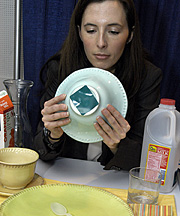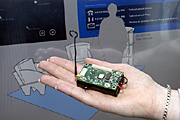 |
Intel Showcases Innovative Wireless Sensor Networks For In-Home Health Care SolutionsGovernment, Industry Urged to Support Technologies to Assist Aging PopulationWASHINGTON, D.C., March 16, 2004 - Intel Corporation is giving government officials a first-hand look at compelling future in-home health care applications at a technology demonstration hosted today by the Center for Aging Services Technologies (CAST). In-home technology prototypes illustrate how tiny silicon-based sensing devices, discreetly embedded in objects such as shoes, furniture and home appliances, could make it possible for elders, Alzheimer's disease patients and others with disabling conditions to continue to live at home. Intel and university researchers determined that wireless sensor networks, combined with powerful computing and complex algorithms, can effectively send prompts through various household devices to assist the elderly and infirm, as well as ease the workload of caregivers. Eric Dishman, director of Intel's proactive health research, is the chairman of CAST, an initiative that brings together researchers and representatives from academia and technology and health care industries to focus on technology applications as potential solutions for the challenges posted by a significant increase in the population of people age 65 and older. He said technologies developed by Intel and university researchers offer evidence that research and development can produce essential solutions to address the cresting "age wave" that could tax an increasingly overburdened health care system. "Our research shows that wireless sensor networks are an extremely promising area for home health technology development," Dishman said. "This technology could enable people to age in place with greater dignity, safety and independence, and help them manage health care costs without compromising quality of care. Sensor networks could also offer greater peace of mind to caregivers and family members, many of whom struggle to provide around-the-clock care." In a week of events centered on the nation's capital, Intel and many members of CAST are calling on congressional leaders and other government officials to join the technology industry as it gives more attention to home health technologies. Intel envisions an interagency commission focused on enabling the development of cost-effective technology solutions that can help prepare the nation for a senior population expected to double over the next 10 to 15 years. Intel initiated home health and wellness initiatives last year that span the computing and communications industries and university research labs, including the formation of CAST. "These cross-industry R&D investments make it clear that innovation in the area of home health technology is thriving in the United States, but it's also critical for government to get more involved in addressing the challenges that will come with the doubling of our senior population," said Pat Gelsinger, Intel senior vice president and chief technology officer. "With the backing of government resources, we could do a better job of stimulating technology innovation that helps people and creates new business opportunities," Gelsinger said, adding that while health care is one of the largest segments of the U.S. gross domestic product, it has not fully capitalized on the benefits of technology. Smart Home Sensor Networks Pose Solutions for Aging "Boomers" Wireless sensor network technology was developed by Intel in collaboration with university researchers. Early on, researchers focused their attention on in-home eldercare, driven by worldwide aging demographics and high incidence of cognitive impairments. Intel's prototype sensor networks make up two of 16 exhibits in today's CAST technology showcase. The "Sensing Social Health" demo looks for sudden declines in social contact, visually tracks a person's daily interaction with others through sensors embedded throughout the home, and employs a screen phone that uses the sensor-delivered data to provide rich contextual cues, such as who is calling, when the parties last spoke and what was discussed. Originated by Intel's proactive health research, the prototype is based on results from a year-long field study of families dealing with Alzheimer's disease and other cognitive disorders. Intel plans to begin home trials of this sensor network in the second half of 2004. The second demo, called "Caregiver's Assistant and CareNet Display: Making Eldercare Easier," show a smart home system that detects, monitors and records the daily living activities of an elder by collecting data through postage stamp-sized wireless Radio Frequency Identification (RFID) tags affixed to household objects. Ultimately the system could help manage everyday activities so that the elders' independence is maintained while relieving some of the burden of around-the-clock care by caregivers. Beyond Health Care Applications Applications such as these will be discussed by David Tennenhouse, vice president and director of research for Intel, at a Sensor Network Applications Open House on March 17. Representatives from the government and leading universities will join Tennenhouse in demonstrating the ways in which wireless sensor networks could change the way people live, work and play. The sensor network applications open house is slated from 12 to 2:30 p.m. in the Rayburn Foyer of the Rayburn House Office Building in Washington. Additional information about the open house and Intel's participation in the CAST technology demonstration is available at techresearch.intel.com/index.aspx. * Other names and brands may be claimed as the property of others. Intel is a registered trademark of Intel Corporation or its subsidiaries in the United States and other countries. |
Intel Wireless Sensor Network Backgrounder
Click on the image to download
|


